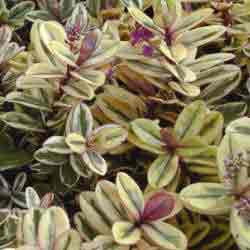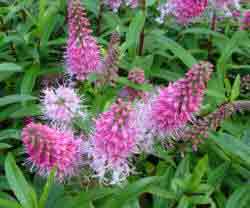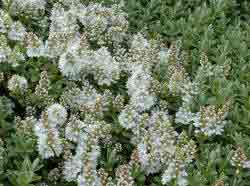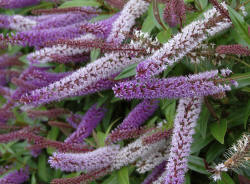Hebe Plant | Evergreen shrub | Shrubby Veronica
In this section, we are concerned with Hebes that are grown as shrubs. The shrubs in this wide group are normally evergreen with varying degrees of winter hardiness and generally attractive flowers. There are also some variegated types and with otherwise coloured foliage - particularly silver types.
(Hebe – pronounced ‘Hee-bee’ is derived from Greek mythology where Hebe is the Goddess of Youth.) The main common name for the Hebe group is Veronica – an older term that was brought about by Hebes being grouped in the Veronica main family. Nowadays, they are Hebes, with the veronicas being a group of perennial plants – distinct from Hebes, though with somewhat similar flowers.
Hebes are known for their spikes of flowers, with many individual flowers making up the main flower spike. The leaves are normally set in groups of four around the stem with two opposite pairs set above each other in every grouping of four.
Hebe shrubs should not be planted in areas of long freezing cold winters, and are generally more suited to milder areas. Much depends upon the variety of Hebe, with the smaller leaved plants- especially the prostrate Hebes - doing better in cold areas.
 It is not easy to generalise about Hebe shrubs, for they have a wide
range of growth habits, including small to medium heights and flower
colours from pure white through blue and pink shades to deep red.
It is not easy to generalise about Hebe shrubs, for they have a wide
range of growth habits, including small to medium heights and flower
colours from pure white through blue and pink shades to deep red.
As with many of our most popular shrubs, Hebes mainly originated from New Zealand, but some also from the south of Australia and others from southern Americas. Their range of natural habitats make them interesting for many different garden applications, and a wide range of locales, in particular, coastal areas where the salt-laden winds are so often lethal to many plants.
Versatile Hebes
In short there are Hebes which are suitable as specimen, container, border, rockery and groundcover situations and hedges. There are very few plants where the general planting advice, is to plant in poor seemingly lifeless soils. Hebes are one of the few.
Soil type seems not to matter as long as there is reasonable drainage. Otherwise a wide range of ph levels is acceptable, and i have planted and grown most type in most soils. Such versatility!
The suitability for different planting places can be governed by a little knowledge upon the original habitat.
- The larger leaved varieties are best suited to coastal areas and inland areas in full sun or dappled shade – their natural habitat.
- The smaller leaved Hebes are best suited drier areas and positions, as they hail from higher altitude habitats.
- The prostrate and whipcord Hebes are the stuff of the Alpine areas.
 That
having been said, most I have grown in what I consider to be ‘normal’
gardening areas, without any problems.
That
having been said, most I have grown in what I consider to be ‘normal’
gardening areas, without any problems.
Flowering period depends upon the variety of individual Hebe, and can start in early summer with some varieties lasting well into the Autumn or even early winter.
Flowering period can be prolonged by regular removal of faded flowers, which encourages a further flush of blooms.
Hebes and Wildlife
The full range of Hebe plants are attractive for a wide range of insect life – in particular for those with physical make-up to reach inside the somewhat tubular flowers of the larger flowered varieties. Bees, butterflies and many other beneficial and attractive flying insects are attracted. Because of the vague similarity between Hebe and Buddleia flowers they are sometimes erroneously called butterfly Bushes, which of course is the accepted common name of the Buddleia.
Planting Hebes


The main consideration when planting Hebes is that they are best planted away from cold, drying winds that can sometimes scorch the foliage - especially in cold winter areas. Full sun or slight shade is suitable for all types including the dappled shade in light woodland areas. The low growing silver foliage types are best in open aspects, where they will not get smothered with fallen leaves in autumn and winter.
In any new garden or planting scheme, Hebes are one of the first that come to mind, not simply as a personal preference, but in the realisation that Hebes rarely fail to please or fulfill the function they have been included for.
Add to all this the fact that Hebes are easy to propagate from cuttings, sometimes set seed in situ, and rarely have problems of a serious nature, you will soon that the Hebe group of shrubs is one not to be ignored .
Best Selling Gardening Products
Popular Gardening Sections

Problems
Identify Weeds in The Garden - How to deal with weeds. Diseases and Pest which harm your garden and plants, learn how to prevent, deter and erradicate your garden problems.
Garden Problems
Pruning
Pruning Guide. Shrubs flower better with correct pruning. Many illustrations and examples of what to do - and when. Includes evergreens, roses, flowering shrubs, spring flowering shrubs and pruning for stem effect. This is our most viewed and comprehensive section,
Pruning
Gardening Businesses
Gardening Businesses listed in the UK counties and USA states. County and State Listings of businesses involved in Garden supplies and services. If you wish to be added to the Directory, please send us your information. Having problems, use the search box
Businesses
Gardening
In this section you will learn about Gardening Basics, Containers, Landscaping, Propagation and Soil.
Gardening
Gardening Gifts
Gardening Gifts and Reviews, Read Before you Buy
- Gardening Gifts Ideas
- Gifts For Her
- Gifts For Men
- Power Tool Gifts
- Cheap Gifts
- Personalised Gifts
- Wildlife Gifts
- Family Gifts



